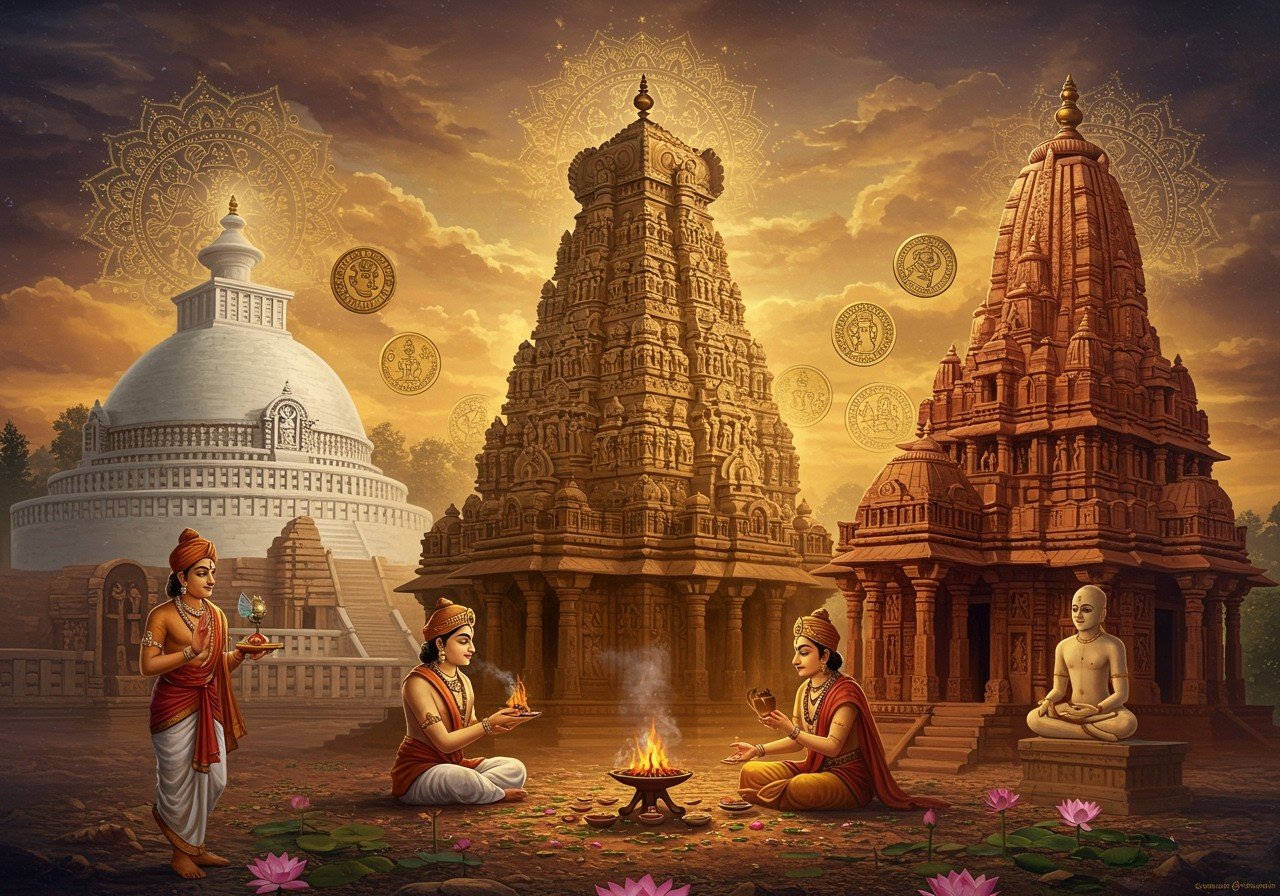
The Satavahana dynasty, also known as the Andhras, a prominent Indian dynasty that reigned from the late 2nd century BCE to the early 3rd century CE, significantly shaped the religious and cultural landscape of ancient India. This blog post delves into the religious environment of the Satavahana dynasty, exploring the interplay of various faiths, primarily Hinduism and Buddhism, and the role of Brahmins within their society. We will examine how the Satavahanas fostered religious diversity and how this influenced their administration and cultural policies.
The Satavahana Dynasty: An Overview
Emerging after the decline of the Maurya Empire, the Satavahanas played a vital role in revitalizing Vedic traditions and championing religious tolerance. Their capital cities, such as Pratishthana (modern-day Paithan) and Amaravati, became important religious and cultural hubs. Their reign is distinguished by the construction of numerous stupas, temples, and other religious monuments, reflecting their dedication to both Buddhism and Hinduism. Notable Satavahana rulers like Gautamiputra Satakarni and Vashishtiputra Pulumavi are renowned for their patronage of religious institutions and their efforts to integrate diverse religious practices.
Brahmanical Traditions in the Satavahana Dynasty
The Satavahanas actively supported Brahmanical traditions, encompassing Vedic rituals and the promotion of Brahmin priests. They performed elaborate sacrifices, including the Ashvamedha (horse sacrifice) and Rajasuya (royal consecration), to legitimize their rule. Inscriptions and coins from their era frequently depict Hindu deities, demonstrating reverence for gods like Vishnu and Shiva. By granting land to Brahmins, the Satavahanas facilitated the spread of Vedic culture throughout their empire. They also supported the construction of temples and the preservation of religious texts. Brahmins held influential positions as advisors, priests, and scholars in the administration, shaping the dynasty’s religious and cultural policies.
Buddhism in the Satavahana Dynasty
Under the patronage of the Satavahana rulers, Buddhism flourished, leading to a remarkable growth of Buddhist art and architecture. The dynasty supported the construction of stupas, viharas (monasteries), and chaityas (prayer halls) at significant sites like Sanchi, Amaravati, and Karle. The Satavahanas provided land and resources to Buddhist monks for the upkeep of monasteries. Inscriptions on the gateways of stupas often record donations by Satavahana kings and queens, highlighting their commitment to Buddhism. The Amaravati School of Art also thrived during their reign.
Religious Syncretism and Tolerance
The Satavahana dynasty serves as a prime example of religious tolerance and syncretism. They fostered an environment where multiple religions could coexist harmoniously, contributing to social stability within their diverse empire. The rulers themselves often engaged in both Hindu and Buddhist rituals, reflecting their inclusive worldview. Inscriptions and artwork from this period showcase a blend of Hindu and Buddhist symbols, indicating a syncretic religious culture. The Satavahanas extended their support to both Brahmanical and Buddhist institutions, while Jainism also received patronage from local elites.
Influence of Trade and Commerce on Religion
The vast trade networks of the Satavahana dynasty significantly influenced their religious landscape. Their trade routes connected them to Southeast Asia, the Roman Empire, and Central Asia, facilitating the exchange of religious ideas and practices. The prosperity generated from trade enabled the Satavahanas to support religious institutions and undertake large-scale construction projects. Ports and cities along trade routes became melting pots of diverse cultures and religions, further enriching the dynasty’s religious diversity. Foreign merchants and travelers introduced new religious practices and artistic styles to the Satavahana territories. The dynasty’s involvement in maritime trade played a crucial role in spreading Buddhism to other parts of Asia.
How Poojn.in Helps You Connect with Satavahana-Era Deities Today
Poojn.in offers authentic puja items and religious resources to help you honor the principal deities revered during the Satavahana period (late 2nd century BCE – early 3rd century CE). Our collection includes:
- Complete puja sets for Lord Vishnu worship: These sets include items like brass diyas, incense holders, and special offerings, enabling devotees to perform traditional Vishnu pujas. We ensure all items are crafted according to traditional standards.
- Traditional items for Lord Brahma pujas: Discover authentic materials for Brahma worship, carefully curated to align with ancient customs. Our product descriptions explain the significance of each item.
- Authentic materials for Lord Shiva abhishekam and worship: Find everything you need for Shiva puja, from abhishekam vessels to rudraksha malas. We provide guidance on proper usage.
Visit our dedicated sections for:
Conclusion
The Satavahana dynasty represents a remarkable era of religious diversity and harmony. Their policy of religious tolerance allowed Hinduism, Buddhism, and Jainism to thrive concurrently. This inclusive approach fostered a peaceful and unified society. The influence of trade and commerce further enriched the religious landscape, with connections to distant lands bringing new ideas and practices. The Satavahanas’ support of religious institutions through their prosperity led to significant cultural and architectural achievements. By embracing diverse beliefs and encouraging mutual respect, the Satavahanas left a legacy of unity in diversity, inspiring us with their example of religious syncretism.
FAQs on The Religious Landscape of the Satavahana Dynasty
What were the primary religions during the Satavahana Dynasty (late 2nd century BCE – early 3rd century CE)? Hinduism, Buddhism, and Jainism were the main religions practiced.
How prominent was Buddhism during this period? Buddhism flourished under Satavahana rule, evident in the numerous Buddhist stupas and viharas built during their reign.
Did the Satavahanas support the Brahmin community? Yes, they actively supported Brahmins, granting them land and resources and promoting Vedic rituals.
Were there any important Buddhist sites from this era? Amaravati, Nagarjunakonda, and Sanchi are among the significant Buddhist sites from the Satavahana period.
How did the Satavahana rulers contribute to religious architecture? They commissioned the construction of stupas, viharas, temples, and other religious structures.
Did Jainism exist during the Satavahana Dynasty? While present, Jainism wasn’t as widespread as Hinduism and Buddhism.
What was the role of religion in their governance? Religion played a key role, with rulers often patronizing religious institutions and promoting religious practices.
Was there inter-religious conflict? There’s no significant evidence of inter-religious conflict. Different religions coexisted peacefully.


